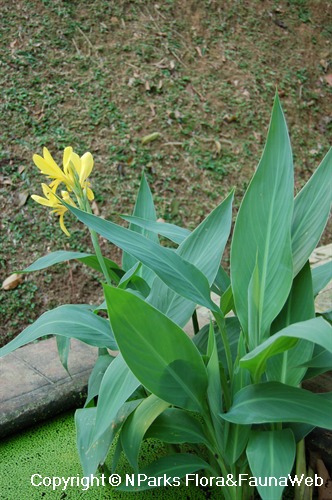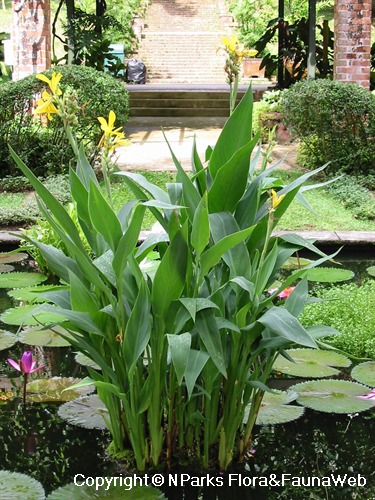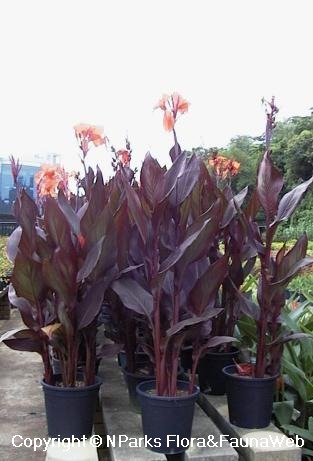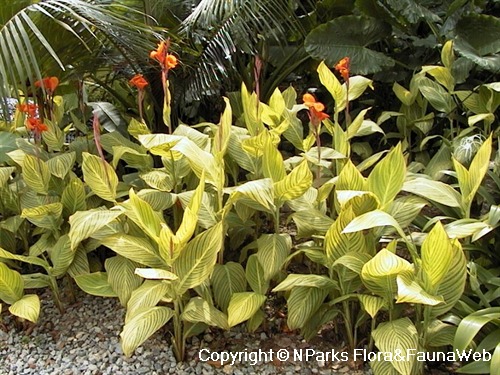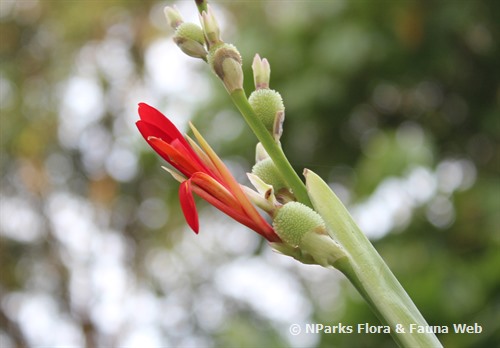
Back
Canna glauca L.
| Family Name: | Cannaceae |
| Synonyms: | Canna angustifolia, Canna annaei, Canna fintelmannii, Canna hassleriana, Canna jacobiniflora, Canna lancifolia, Canna liturata, Canna longifolia, Canna mexicana, Canna pedicellata, Canna siamensis, Canna stenantha, Canna stolonifera, Canna stricta |
| Common Name: | Aquatic Canna |
Name
Classifications and Characteristics
| Plant Division | Angiosperms (Flowering Seed Plants) (Monocotyledon) |
|---|---|
| Plant Growth Form | Aquatic & Hydrophyte (Emergent Aquatic, Waterside / Marginal), Herbaceous Plant |
| Lifespan (in Singapore) | Perennial |
| Mode of Nutrition | Autotrophic |
Biogeography
| Native Distribution | Tropical America |
|---|---|
| Native Habitat | Aquatic |
| Local Conservation Status | Non-native (Horticultural / Cultivated Only) |
Description and Ethnobotany
| Growth Form | It is a herbaceous perennial which has unbranched stems and grows up to 1 m tall. |
|---|---|
| Foliage | Leaf blades are light green, narrowly ovate, measures 28 - 70 cm long and 1.5 - 14 cm wide, and clasping the stem at the base; both sheath and blade are glaucous, base cuneate, apex acute. |
| Flowers | Inflorescence, raceme, at least 10 flowers per inflorescence, each flower is 7 - 10 cm long, yellow, bracts ovate; sepals narrowly elliptic, petals tube-like. |
| Fruit | Fruit capsule, measures 2 - 5 cm long and 2 - 4 cm wide, globose to ellipsoid shape, young immature fruits are covered with small wart-like pattern on the fruit surface. When the fruit matures, it releases numerous seeds through the valves at the fruit top. Seeds are 0.7 - 1 mm x 0.6 - 0.8 mm, and brown mottled with black. |
| Habitat | It grows in marshes, ponds and swamps. |
| Etymology | The genus term Canna means cane, reed which relates to the growing habit similar to grass in wetlands. The specific epithet glauca means greyish-green, which refers to its leaf. |
| Ethnobotanical Uses | Edible Plant Parts : Edible Stems Food (Fruit or Vegetable): Its underground stems (rhizomes) is starchy and therefore eaten as a staple in the Andean areas of Southern America. The rhizomes were used as famine food during World War II. |
Landscaping Features
| Desirable Plant Features | Ornamental Flowers |
|---|---|
| Landscape Uses | Pond / Lake / River, Marsh / Bog, Container Planting |
Fauna, Pollination and Dispersal
| Seed or Spore Dispersal | Abiotic |
|---|
Plant Care and Propagation
| Light Preference | Full Sun |
|---|---|
| Water Preference | Lots of Water |
| Rootzone Tolerance | Moist Soils, Waterlogged Soils |
| Propagation Method | Seed, Root Cutting, Division |
Foliar
| Foliage Retention | Evergreen |
|---|---|
| Mature Foliage Colour(s) | Green |
| Mature Foliage Texture(s) | Smooth |
| Foliar Shape(s) | Non-Palm Foliage (Ovate) |
| Foliar Margin | Entire |
| Foliar Apex - Tip | Acuminate |
| Foliar Base | Cuneate |
Floral (Angiosperm)
| Flower & Plant Sexuality | Bisexual Flowers |
| Flower Colour(s) | Yellow / Golden |
|---|---|
| Flower Grouping | Cluster / Inflorescence |
| Individual Flower Shape | Tubular |
| Inflorescence Type | Raceme |
Fruit, Seed and Spore
| Mature Seed Colour(s) | Black, Brown |
|---|---|
| Seed Quantity Per Fruit | Numerous (>20) |
Image Repository
Others
| Master ID | 481 |
|---|---|
| Species ID | 1777 |
| Flora Disclaimer | The information in this website has been compiled from reliable sources, such as reference works on medicinal plants. It is not a substitute for medical advice or treatment and NParks does not purport to provide any medical advice. Readers should always consult his/her physician before using or consuming a plant for medicinal purposes. |

